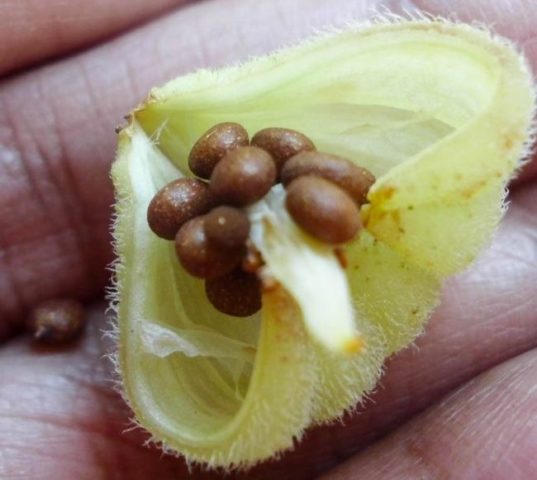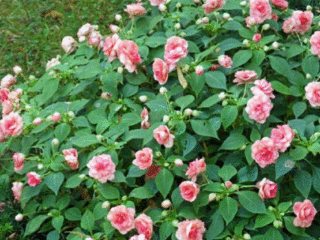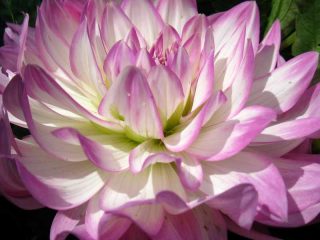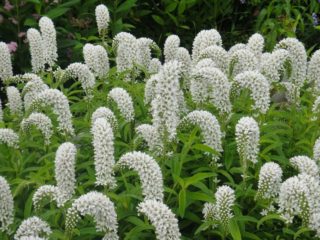Content
Sowing balsam for seedlings is one of the most popular ways to cultivate this type of plant. The method is simple and can be implemented at home even by novice growers.
Features of growing balsam from seeds at home
"Balsamin" is a herbaceous plant that belongs to the group of both annuals and perennials. Its main feature is the variety of varieties. The latter factor affects the timing of disembarkation and the characteristics of care.
"Balsam" is a plant with jagged or rounded leaf plates of a dark green palette and flowers of various shades (pink, red, white). Inflorescence petals can be smooth, double or semi-double. Flowering does not occur simultaneously.

In good conditions, balsam blooms all year round
What balsam seeds look like
Balsam fruits are small seed pods that open when lightly touched. The seeds themselves are very small, of different sizes, covered with a dark brown, black or white shell. In annuals, the seed is usually slightly larger than in perennial crops.

All seeds require pre-treatment before planting.
How to collect balsam seeds
Collection of balsam seeds has its own characteristics. The fruits of the plant cannot be cut off ahead of time, otherwise the seeds will rot. It is very simple to determine the onset of the moment of ripening: you need to pick up the seed capsule, if the flaps open immediately, then the time for collection has come.
The storage period of balsam seeds can reach 6-8 years, however, only freshly harvested materials show the best germination.
When to sow balsam for seedlings
It is more expedient to plant balsam for seedlings in the last decade of March or in the first of April. However, the timing of disembarkation depends more on the region and its climatic conditions.
In the southern regions, planting can begin in the first half of February, while in the middle lane, namely in the Moscow region, the optimal time is in early spring. In Siberia, Leningrad Oblast, Karelia and the Urals, the landing date may be postponed to early April.
Most gardeners use the lunar calendar when calculating planting dates.
Auspicious days:
- from 12 to 17, 19 and 20 March;
- April 6-8, 11-13, 15-17, 29 and 30.
The following are considered unfavorable:
- 6 and 7, March 21;
- April 5 and 19.
You can also determine the timing of disembarkation in the opposite way. Since the balsam transplant most often takes place in late May-early June, and the cultivation of seedlings takes 3-4 months, depending on the region, the sowing date is determined by a countdown.
How to properly plant balsam for seedlings
It is possible to competently plant balsam for seedlings only after having previously studied all the subtleties and nuances of the process itself, as well as the subsequent agricultural technology. Most varieties of this crop can be planted with seeds.
Selection and preparation of containers
The optimal choice for planting balsam with seeds will be a small container up to 10-12 cm deep. It can be planted both in small separate containers and in one large box, the main thing is to choose the right width based on the number of seeds. Subsequently, you can always make a pick and successfully plant young plants.
At home, flower growers actively use plastic cups and cassettes, small pots and peat tablets. Each future seedlings should have a volume of at least 200-220 ml.

Seeds must be disinfected before planting.
Before use, it is necessary to treat the container with antiseptics or a solution of potassium permanganate for complete disinfection. Tight plastic containers can be scalded with boiling water (excluding cups).
Each seedling container must be equipped with a drainage hole. If this is not available, you need to make it yourself.
Soil preparation
Balsam appreciates light fertile soil with high characteristics of air and water permeability, as well as with a moderately acidic environment. Dense soil, generously composted, is not the best option.
You can buy a suitable soil for balsam at a specialty store or make it yourself by mixing in equal proportions turf soil, peat, perlite and sand. It is advisable to pass all the ingredients of the mixture through a wide sieve. This will make the soil looser, and also saturate it with oxygen.
Preparation of balsam seeds for sowing
It is possible to increase the germination rate of seedlings by preliminary preparation of the seed material. For this, the seeds are etched, thus removing pathogens and bacteria from the surface of their shell.
As a disinfectant, Fitosporin-M is most often used. The processing time with the drug should not exceed 25-30 minutes. After dressing, the seeds are soaked in growth stimulants (Zircon, Epin-Extra).
The processing procedure allows you to accelerate the germination of seedlings.
Algorithm for planting balsam seeds for seedlings
There is nothing difficult in planting balsam. The working algorithm includes the following operations:
- Laying a drainage layer on the bottom of the container (gravel, perlite).
- Filling the container with prepared soil (not reaching 1.5-2 cm to the edge).
- Leveling and moistening the soil (using a spray gun).
- Sowing seeds at a distance of 3-3.5 cm from each other.
- Second watering (spraying).
- Covering the container with glass, plastic lid or cling film.
For convenience, you can sign the plant. For example, if several types of crops are sown at the same time.

You can take purchased soil or make a soil mixture yourself
How to grow balsam from seeds
It is possible to grow high-quality seedlings only by creating a healthy microclimate for the plant. An important role in the growth of balsam is played by its agricultural technology.
How many days does balsam seedlings grow?
According to reviews, balsam emerges from seeds about 1-3 weeks after planting. As a rule, fresh materials show a higher "pecking" rate. You need to understand that you should not expect a friendly and simultaneous seedling emergence from this plant.
There are a number of reasons that influence this process:
- too low soil temperature;
- high soil temperature (above + 25 ° С), at which the seeds die;
- heavy composition;
- expired seed material;
- high acidity of the soil.
The microclimate organized by the florist is also important.
Microclimate
Optimal conditions include not only air temperature and humidity, but also lighting.It is necessary to grow seedlings in a bright place with sufficient sunlight. The length of daylight hours for balsam should vary from 12 to 14 hours. In winter and early spring, it can be regulated using phytolamps.
The optimum air temperature is 23-25 ° С. Balsam requires airing 2 times a day (morning and evening) for 12-15 minutes. The soil should not dry out, therefore, air humidity and timely watering must also be carefully monitored.
When the first sprouts of seedlings appear, the ambient temperature should be lowered by 5-7 ° C. Airing time can be extended up to 3 weeks after planting. First, bring it to 1 hour, then gradually to 3-4. By the end of the week - up to 5-6 hours.
Watering and feeding
It is impossible to grow balsam seedlings from seeds without properly organized watering.
The soil is moistened with a syringe, a small watering can or a large syringe. Watering is root-based. The frequency depends on the humidity of the air and the rate of drying of the top layer of the soil (it should always be slightly damp).

When watering from a watering can, it is important to direct the water to the root.
The water used for watering balsam seedlings should be settled, without impurities, at room temperature. Top dressing is carried out in conjunction with watering, using rapidly dissolving mineral complexes with nitrogen.
The first fertilizer is applied only after the appearance of the first leaf. Subsequent dressings can be applied once every 10-12 days.
What to do if balsam seedlings are stretched out
In some cases, you can observe how the balsam seedlings are excessively stretched, making the plants more fragile. The causes of the phenomenon can be:
- planting too early;
- violation of the temperature regime;
- lack of lighting.
Solve the problem in the following ways:
- Increase the daylight hours of the plant using phytolamps.
- Arrange pinching.
- A pick is made.
In the latter case, the plant is slightly buried in order to remove the excess load from the shoot.
Picking
A pick is carried out only in the presence of at least 2 well-developed leaf plates. Seedlings are transplanted into individual peat cups or cassettes with drainage holes. In this case, you can use the same soil that was used for planting seeds.
It is possible to reduce the stress level during picking by using special solutions, for example, "Epin-Extra". For this, the plant is sprayed from a spray bottle on the eve of transplantation and 2 days after it.

The drug "Epin-Extra" is also used as a growth stimulant
The picking algorithm is as follows:
- One hour before the procedure, the soil should be well moistened.
- New cups should be filled with enriched soil, making a small hole in the middle.
- Monitor all seedlings and get rid of weak and painful specimens.
- Pick up the plant along with a lump of earth that protects the root process, and carefully transplant it to a new place, deepening the seedling to the cotyledonous leaf.
- Sprinkle with soil on top and tamp lightly.
The main characteristics of the microclimate do not change after the pick.
The first 3 days after the pick, the plant is under stress. Experts advise to slightly shade the seedlings for this period. After 2 weeks, you can feed the balsam with any mineral complex.
Topping
1-2 weeks after the transplant, the balsam is pinched with fingers or scissors. Any instrument is pre-disinfected. The pinching procedure stimulates the growth of lateral shoots, which significantly increases the decorative qualities of the future bush, making it more lush and attractive. After pinching, the seedlings are watered with settled water.
Hardening
The hardening procedure is necessary to increase the adaptive qualities of the plant after it is planted in open ground.For 10-15 days, the seedlings begin to be taken out to the loggia or fresh air, gradually increasing the time spent in a less comfortable temperature regime.
Transfer to the ground
Planting balsam from seeds is only the first stage in the cultivation of this plant. The final operation is to plant seedlings in open ground. The main condition is the correct selection of the place. It should not be too open (balsam withers in direct sunlight), but not in the shade.
The transplant procedure is indistinguishable from a pick. At the end, the plant should be watered (at the root) and observed for at least two weeks as it takes root.
Conclusion
Sowing balsam for seedlings is not a very difficult event, but with its own nuances. Correctly grown and planted balsam will become the main decoration of the garden or home, depending on the place of its cultivation.








